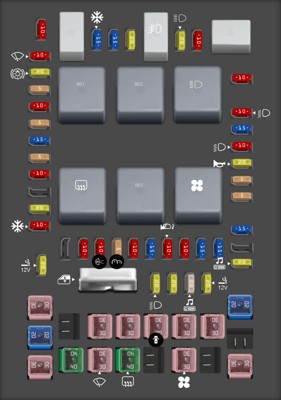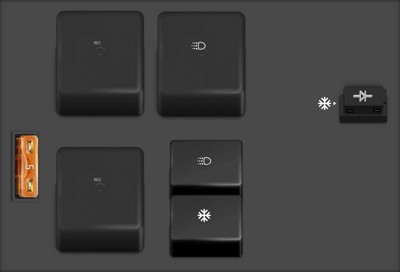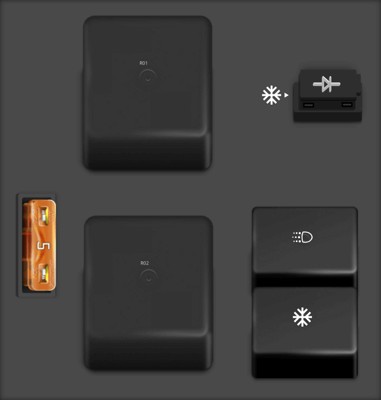Diagnosing issues in your 2004 Ford F-150 often starts with connecting an OBD2 scanner to the diagnostic port. But what happens when your scanner fails to power up? A common culprit is a blown fuse related to the OBD2 port. Locating the correct fuse is crucial for a quick fix, allowing you to proceed with your vehicle diagnostics. This guide will pinpoint the 2004 Ford F-150 OBD2 fuse location and provide comprehensive information about the fuse boxes in your truck.
The 2004 Ford F-150 is equipped with multiple fuse boxes strategically placed to protect various electrical circuits. For diagnostic purposes and specifically the OBD2 port, you’ll primarily be interested in the fuse box located inside the passenger compartment.
To effectively troubleshoot fuse-related issues, understanding the layout and function of each fuse box is essential. Let’s explore the fuse box diagrams and identify the fuse relevant to your OBD2 port.
Passenger Compartment Fuse Box Diagram
The primary fuse box you’ll need to access for the OBD2 port is situated within the passenger compartment of your 2004 Ford F-150. This fuse panel, also acting as a power distribution box, houses fuses that control numerous interior and some exterior functions.
 2004 Ford F-150 passenger compartment fuse panel diagram
2004 Ford F-150 passenger compartment fuse panel diagram
2004 Ford F-150 passenger compartment fuse panel diagram showcasing the layout and location of various fuses.
Within this fuse box, you’ll find a fuse specifically designated for the diagnostic connector, which powers your OBD2 port. Referring to the diagram and the fuse list, locate the fuse associated with the diagnostic connector.
| Type | No. | Description |
|---|---|---|
| Fuse MINI 10A | 1 | Run/Accessory – Wipers, Instrument cluster |
| Fuse MINI 20A | 2 | Stop/Turn lamps, Speed control deactivate switch |
| Fuse MINI 5A | 3 | Power mirrors, Memory logic power, Memory seats and pedals |
| Fuse MINI 10A | 4 | DVD battery power |
| Fuse MINI 5A | 5 | Keep alive memory for Powertrain Control Module (PCM) and climate control module |
| Fuse MINI 15A | 6 | Parklamps, BSM, Instrument panel illumination |
| Fuse MINI 5A | 7 | Radio (start signal) |
| Fuse MINI 10A | 8 | Heated mirrors, Switch indicator |
| Fuse MINI 20A | 10 | Trailer tow back-up lamps relay (PCB1), Trailer tow parklamp relay (R201) |
| Fuse MINI 10A | 11 | A/C clutch, 4×4 solenoid |
| Fuse MINI 10A | 13 | Climate control module power |
| Fuse MINI 10A | 14 | Back-up lamp and Daytime Running Lamps (DRL) relay coil, A/C pressure switch, Brake-shift interlock solenoid |
| Fuse MINI 5A | 15 | Overdrive cancel, Cluster, Brake-Shift Interlock (BSI) |
| Fuse MINI 10A | 16 | ABS module (Run/Start power) |
| Fuse MINI 15A | 17 | Fog lamp relay (R202) |
| Fuse MINI 10A | 18 | Run/Start feed – Flasher relay, Electrochromatic mirror, Heated seats, BSM, Compass, RSS (Reverse Sensing System) |
| Fuse MINI 10A | 19 | Restraints (Air bag module) |
| Fuse MINI 15A | 20 | PCM 4×4 power |
| Fuse MINI 15A | 21 | Cluster keep alive power |
| Fuse MINI 10A | 22 | Delayed accessory power for audio, power door lock switch and moonroof switch illumination |
| Fuse MINI 10A | 23 | RH low beam headlamp |
| Fuse MINI 15A | 24 | Battery saver power for demand lamps |
| Fuse MINI 10A | 25 | LH low beam headlamp |
| Fuse MINI 20A | 26 | Horn relay (PCB3), Horn power |
| Fuse MINI 5A | 27 | Passenger Air bag Deactivation (PAD) warning lamp, Cluster air bag warning lamp, Cluster RUN /START power |
| Fuse MINI 5A | 28 | SecuriLock transceiver (PATS) |
| Fuse MINI 15A | 29 | PCM 4×4 power |
| Fuse MINI 20A | 31 | Radio power |
| Fuse MINI 15A | 32 | Vapor Management Valve (VMV), A/C clutch relay, Canister vent, Heated Exhaust Gas Oxygen (HEGO) sensors #11 and #21, CMCV, Mass Air Flow (MAF) sensor, VCT |
| Fuse MINI 15A | 33 | Shift solenoid, CMS #12 and #22 |
| Fuse MINI 20A | 34 | Fuel injectors and PCM power |
| Fuse MINI 20A | 35 | Instrument cluster high beam indicator, High beam headlamps |
| Fuse MINI 10A | 36 | Trailer tow right turn/stop lamps |
| Fuse MINI 20A | 37 | Rear power point |
| Fuse MINI 25A | 38 | Subwoofer power |
| Fuse MINI 20A | 39 | Instrument panel power point |
| Fuse MINI 20A | 40 | Low beam headlamps, DRL |
| Fuse MINI 20A | 41 | Cigar lighter, Diagnostic connector power |
| Fuse MINI 10A | 42 | Trailer tow left turn/stop lamps |
| Fuse FMX/JCase 30A | 101 | Starter solenoid |
| Fuse FMX/JCase 20A | 102 | Ignition switch feed |
| Fuse FMX/JCase 20A | 103 | ABS valves |
| Fuse FMX/JCase 30A | 105 | Electric trailer brakes |
| Fuse FMX/JCase 30A | 106 | Trailer tow battery charge |
| Fuse FMX/JCase 30A | 107 | Power door locks (BSM) |
| Fuse FMX/JCase 30A | 108 | Passenger power seat |
| Fuse FMX/JCase 30A | 109 | Driver power seat, Adjustable pedals |
| Fuse FMX/JCase 30A | 111 | 4×4 relays |
| Fuse FMX/JCase 40A | 112 | ABS pump power |
| Fuse FMX/JCase 30A | 113 | Wipers and washer pump |
| Fuse FMX/JCase 40A | 114 | Heated backlite, Heated mirror power |
| Fuse FMX/JCase 30A | 116 | Blower motor |
| Fuse FMX/JCase 30A | 118 | Heated seats |
| Circuit breaker MAXI | 401 | Power windows, Moonroof, Power sliding backlite |
| Relay | R01 | Starter solenoid |
| Relay | R02 | Accessory delay |
| Relay | R03 | Hi-beam headlamps |
| Relay | R04 | Heated backlite |
| Relay | R05 | Trailer tow battery charge |
| Relay | R06 | Blower motor |
| Relay | R201 | Trailer tow park lamps |
| Relay | R202 | Fog lamps |
| Relay | R03 | PCM |
As you can see from the table, Fuse #41, a 20A Mini fuse, is labeled “Cigar lighter, Diagnostic connector power”. This is the fuse that powers your OBD2 port in your 2004 Ford F-150. If your OBD2 scanner is not receiving power, this fuse should be the first point of inspection.
Auxiliary Relay Boxes
While the passenger compartment fuse box is your primary focus for the OBD2 port, the 2004 F-150 also includes auxiliary relay boxes. These boxes primarily manage relays and some fuses for systems like Daytime Running Lamps (DRL) and the air conditioning clutch.
It’s important to note that these auxiliary boxes are less likely to be directly related to OBD2 power issues, but understanding their existence provides a complete picture of your vehicle’s electrical system.
Auxiliary relay box (with DRL):
 2004 Ford F-150 auxiliary relay box with DRL diagram
2004 Ford F-150 auxiliary relay box with DRL diagram
Diagram of the auxiliary relay box (with DRL) in a 2004 Ford F-150, detailing relays and fuse locations.
Auxiliary relay box (without DRL):
 2004 Ford F-150 auxiliary relay box without DRL diagram
2004 Ford F-150 auxiliary relay box without DRL diagram
Diagram of the auxiliary relay box (without DRL) in a 2004 Ford F-150, showing relay and fuse placement.
These auxiliary fuse boxes are typically located in the engine compartment. While they are less relevant to the OBD2 port fuse location, they are part of the overall electrical system of your 2004 F-150.
Checking and Replacing the OBD2 Fuse
Once you’ve located fuse #41 in the passenger compartment fuse box, follow these steps to check and replace it if necessary:
- Turn off the ignition: Ensure your Ford F-150 is completely turned off before working with fuses.
- Locate the passenger compartment fuse box: It’s usually found under the dashboard on the driver’s side or passenger side, depending on the vehicle model and year. Refer to your owner’s manual for the exact location.
- Access the fuse box: Remove the fuse box cover. You might need a screwdriver or simply use your fingers to unclip it.
- Identify fuse #41: Using the diagram and the fuse list provided, locate fuse #41 (20A Mini fuse).
- Inspect the fuse: Carefully pull out the fuse. You can use a fuse puller tool (often included in the fuse box) or needle-nose pliers. Hold the fuse up to the light and check if the thin wire inside is broken or melted. If it is, the fuse is blown.
- Replace the fuse: If the fuse is blown, replace it with a new 20A Mini fuse. Crucially, always use the same type and amperage fuse as the original. Using a fuse with a higher amperage can damage your vehicle’s electrical system.
- Test your OBD2 scanner: After replacing the fuse, plug in your OBD2 scanner to see if it now powers up.
Important Note: If the new fuse blows immediately or repeatedly, it indicates a more significant underlying electrical issue. In such cases, it’s recommended to consult a qualified automotive electrician or technician to diagnose and repair the problem.
Conclusion
Locating the OBD2 fuse in your 2004 Ford F-150 is straightforward once you know where to look. By utilizing the passenger compartment fuse box diagram and identifying fuse #41 (20A), you can quickly check and replace a blown fuse, potentially resolving your OBD2 scanner power issues. Remember to always use the correct replacement fuse and seek professional help if problems persist. This guide empowers you to take a proactive step in diagnosing your vehicle and maintaining its optimal performance.